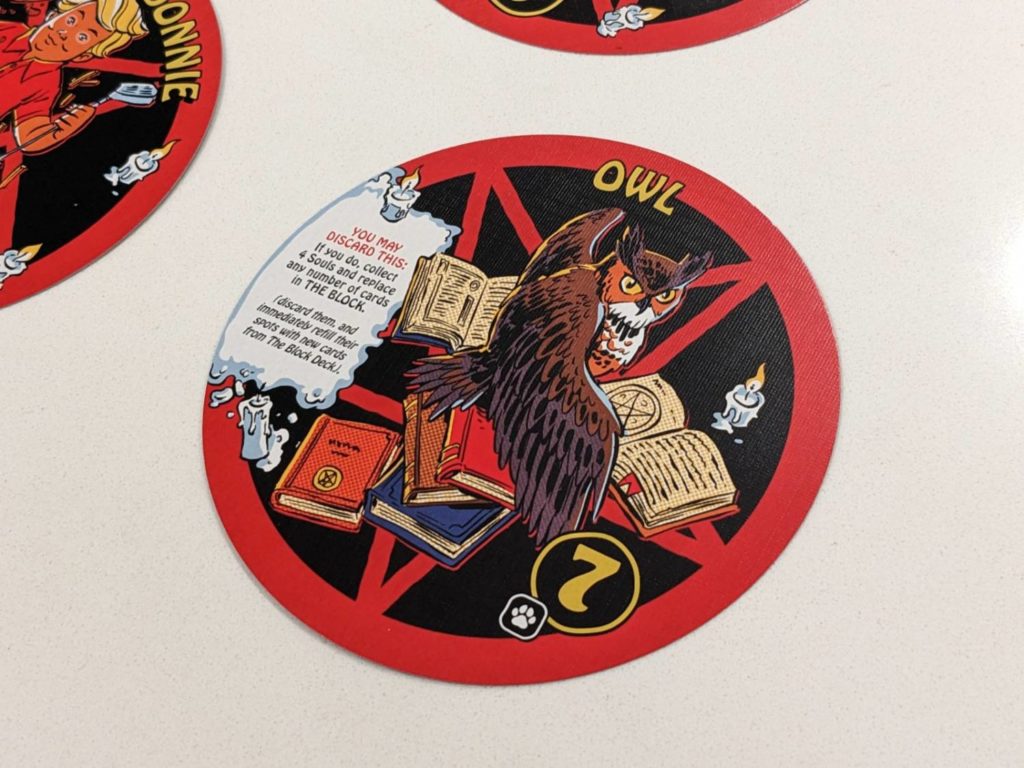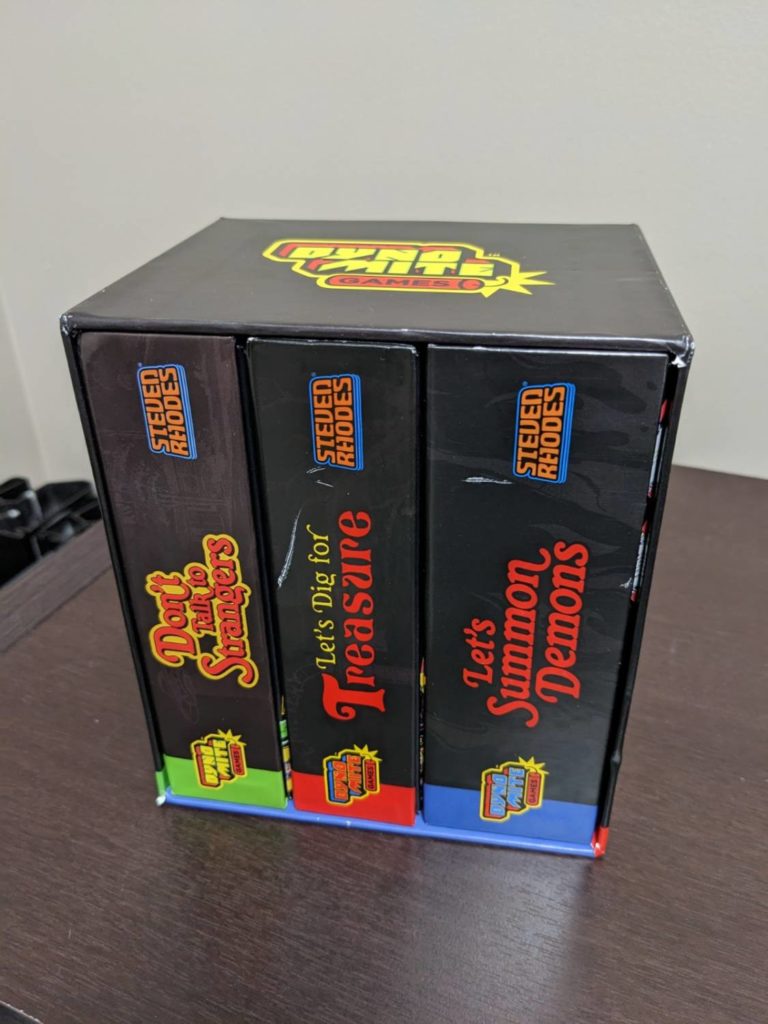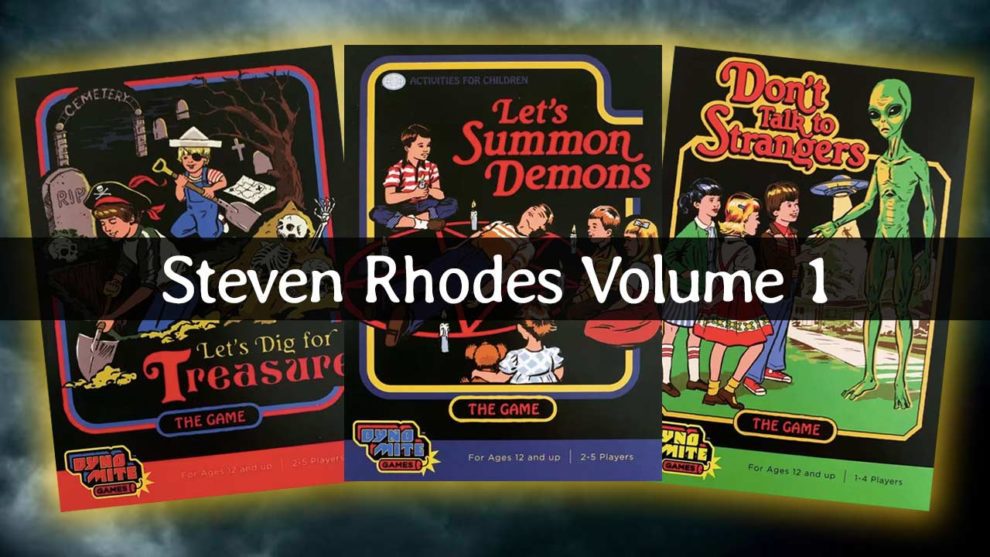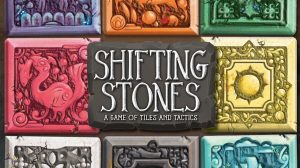Disclosure: Meeple Mountain received a free copy of this product in exchange for an honest, unbiased review. This review is not intended to be an endorsement.
The first time I heard about Steven Rhodes was on Threadless, the clothing website featuring art from hundreds of incredible independent creators. Rhodes has a very iconic style, leaning hard into the recreation of children’s books from the 1970s and 80s. The twist is that for every picture of an innocent-looking child riding a skateboard or digging for treasure, there’s something dark arts-ish going on in the same image.
I spent a lot of time shopping at Threadless, buying shirts and hoodies online then driving down the street (I’m in Chicago, where Threadless is based) to pick up my orders. Although I never bought any of the Rhodes collection for myself, I admired Rhodes’ work from afar.
Cryptozoic Entertainment built an entire series of games around Rhodes’ illustrations, so when I had the chance to review both volumes of the Steven Rhodes Games collection, I raised my hand. The games feature Rhodes’ images throughout, but the games were designed by a collection of other people. The result is a very uneven bag; if you are a fan of the art, my advice is to skip the games altogether, and buy a poster or an action figure from the Steven Rhodes Threadless shop.
There are three bookshelf-sized games in the first volume, a project which raised more than $300,000 on Kickstarter. I played each game a few times for this review, but since I received the games as a collection, I’ll summarize my thoughts on each one here in rank order from best to worst.

Let’s Summon Demons
Fans of Machi Koro and Space Base will be right at home with Let’s Summon Demons. That’s because Let’s Summon Demons feels like a poor man’s version of those other games, but with much funnier pictures on the drink coaster-shaped cards.
Each player begins with a single Candle card and three Demons in their possession, along with a handful of souls, the game’s currency. A market of five cards, known as “The Block”, are available each turn for purchase; by recruiting little boys, girls, and animals, players can choose to “snuff” (discard) three boys/girls/animals on a turn to summon a demon. Demons grant each owner with special ongoing powers for the rest of the game.
Players roll dice to trigger cards in their tableau. Each boy, girl and animal have a number printed on each card; when rolled, that card triggers, usually to produce more souls or provide a one-time discard bonus if other tableau conditions are met. Each card in The Block costs three souls, so having a steady drip of souls is important.
The game ends when a single player has summoned all three of their Demons and they have ten souls in their supply. In my experience, this takes about 30-40 minutes with 2-3 players. (The game accommodates up to four players.)
Let’s Summon Demons is fun, even if it doesn’t hold a candle to any of the games it most closely aligns with. I would play Valeria: Card Kingdoms, Space Base, or even Machi Koro as the “roll dice, get stuff” game of the night over Let’s Summon Demons, but some of the pictures in Let’s Summon Demons are truly hilarious.
This game was the most ideal result of “I want to play a decent game, ideally with a bunch of Steven Rhodes’ artwork.” Let’s Summon Demons doesn’t overstay its welcome and you can teach it in about two minutes. Sadly, the rest of the games in this collection take a dive from here.

Let’s Dig for Treasure
Here’s the concept behind Let’s Dig for Treasure: press your luck, with tons of stabbery, robbery, and comically unbalanced cards.
Now, knowing that the cards are unbalanced makes the game interesting, at least for a little while. A deck of 120 cards is split into three roughly equal facedown piles, and the first player simply draws a card from the top of one of those decks.
You get to keep every card that you find, as long as you walk away before trouble strikes. Many cards have treasure worth anywhere from 0-50 points; some require a named second card to trigger points. Some cards, like Dirt, score a point; Worms score a point too, but if you draw a second Worms card, you lose everything you drew on that turn.
And if anyone ever draws an Evil Skeleton, their turn is over immediately. When one of the three draw stacks empties, the game is over and points are tallied.
Let’s Dig for Treasure is technically a game, but it never feels like you really have much control. I’m OK with that because it’s a chaos bomb packaged as a 20-minute game; one of my plays wrapped up in just 15 minutes. Great. It’s not a game I can recommend because there are dozens, if not hundreds, of other better push-your-luck games out there.
Yes, I know: you came for the Steven Rhodes artwork. Let’s Dig for Treasure has that, but the pictures in this one don’t seem to feature much variety. And by the time you have one of your best point cards stolen by the player on your left, you might be close to flipping the table in disgust anyway.
While Let’s Dig for Treasure isn’t great, it’s a hell of a lot better than our last contestant.

Don’t Talk to Strangers
I had one consistent thought during my plays of Don’t Talk to Strangers. “Clearly, the designers wanted to build a three-game set. With two games in the can, they took a flyer on the final inclusion because this puppy doesn’t feel like a game that saw any playtesting.”
Don’t Talk to Strangers asks players to guide their pool of ten kids to safe places on the map before aliens show up and abduct kids off the board. I’m going to take the high road (mostly) and say that it is safe to skip Don’t Talk to Strangers at all costs.
A few examples:
- Each turn, you can either place a child on the start space, or move one child already on the map by playing a card. However, on multiple turns, we experienced turns where you couldn’t actually move and you couldn’t add any more kids to the map because of the base rules regarding token movement.
- When drawing cards to replace played cards during a turn, you will occasionally flip an alien card. There’s a 50/50 chance that this alien will be placed on one of your kid tokens, which sends them off the board if they are abducted.
- When kids are abducted, they are…returned to your supply. They are never actually abducted. I still can’t figure this one out. Why use the word “abducted”?
- The main deck is called the Move Deck, but a couple dozen cards don’t actually move anyone, anywhere.
- Steven Rhodes artwork is obviously everywhere here too, but the pictures aren’t nearly as silly, weird, or dark as they are in the other two games. This means that somehow, even the artwork in Don’t Talk to Strangers doesn’t work.

The Verdict
I would skip the purchase of this collection, and stick with a purchase of just Let’s Summon Demons from your local game shop or online. At about $15, this is a lighter version of other great games that features the thing you are probably most interested in if you are reading this review: great Steven Rhodes artwork.
The other two games are average or worse, and they won’t get much traction with gamers in most cases. While Don’t Talk to Strangers is a major fail, Let’s Dig for Treasure is serviceable as a push-your-luck filler game.
Based on this information, I’m a little nervous about the second volume of games. I’ll explore that second collection in a month or two!












Add Comment